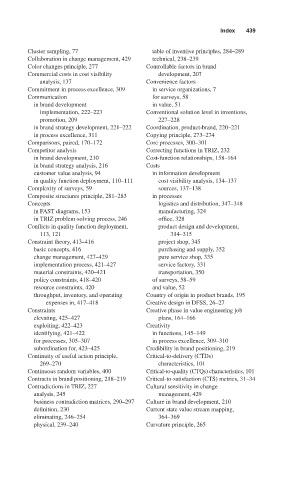Page 481 - Design for Six Sigma for Service (Six SIGMA Operational Methods)
P. 481
Index 439
Cluster sampling, 77 table of inventive principles, 284–289
Collaboration in change management, 429 technical, 238–239
Color changes principle, 277 Controllable factors in brand
Commercial costs in cost visibility development, 207
analysis, 137 Convenience factors
Commitment in process excellence, 309 in service organizations, 7
Communication for surveys, 58
in brand development in value, 51
implementation, 222–223 Conventional solution level in inventions,
promotion, 209 227–228
in brand strategy development, 221–222 Coordination, product-brand, 220–221
in process excellence, 311 Copying principle, 273–274
Comparisons, paired, 170–172 Core processes, 300–301
Competitor analysis Correcting functions in TRIZ, 232
in brand development, 210 Cost-function relationships, 158–164
in brand strategy analysis, 216 Costs
customer value analysis, 94 in information development
in quality function deployment, 110–111 cost visibility analysis, 134–137
Complexity of surveys, 59 sources, 137–138
Composite structures principle, 281–283 in processes
Concepts logistics and distribution, 347–348
in FAST diagrams, 153 manufacturing, 324
in TRIZ problem-solving process, 246 office, 328
Conflicts in quality function deployment, product design and development,
113, 121 314–315
Constraint theory, 413–416 project shop, 345
basic concepts, 416 purchasing and supply, 352
change management, 427–429 pure service shop, 335
implementation process, 421–427 service factory, 331
material constraints, 420–421 transportation, 350
policy constraints, 418–420 of surveys, 58–59
resource constraints, 420 and value, 52
throughput, inventory, and operating Country of origin in product brands, 195
expenses in, 417–418 Creative design in DFSS, 26–27
Constraints Creative phase in value engineering job
elevating, 425–427 plans, 164–166
exploiting, 422–423 Creativity
identifying, 421–422 in functions, 145–149
for processes, 305–307 in process excellence, 309–310
subordination for, 423–425 Credibility in brand positioning, 219
Continuity of useful action principle, Critical-to-delivery (CTDs)
269–270 characteristics, 101
Continuous random variables, 400 Critical-to-quality (CTQs) characteristics, 101
Contracts in brand positioning, 218–219 Critical-to-satisfaction (CTS) metrics, 31–34
Contradictions in TRIZ, 227 Cultural sensitivity in change
analysis, 245 management, 429
business contradiction matrices, 290–297 Culture in brand development, 210
definition, 230 Current state value stream mapping,
eliminating, 246–254 364–369
physical, 239–240 Curvature principle, 265

